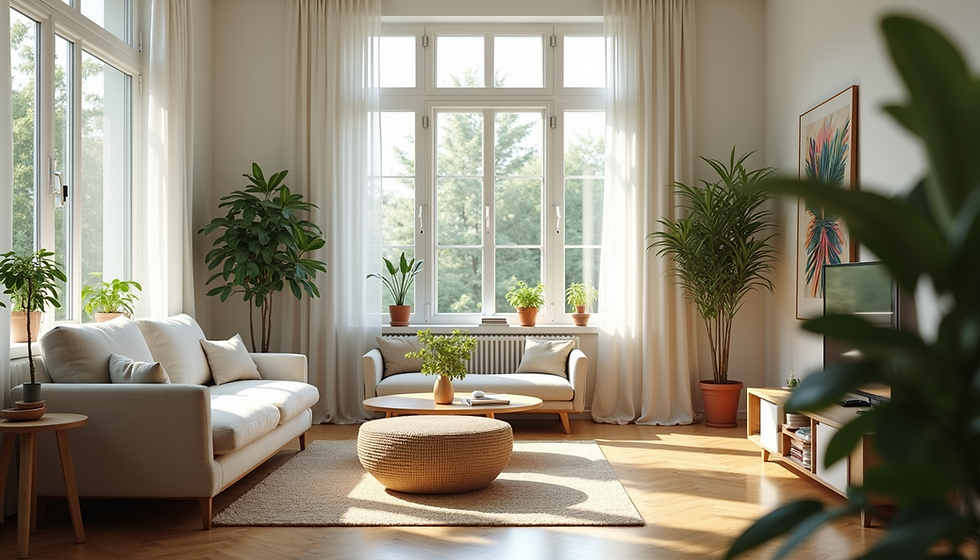How Creativity Shapes Modern Interior Design
- Param J Singh
- Sep 1
- 3 min read
Creativity is the heartbeat of modern interior design. It transforms ordinary spaces into extraordinary environments that reflect personality, culture, and innovation. Today, interior designers are not just decorators; they are visionaries who blend art, functionality, and technology to create spaces that inspire and comfort. This blog explores how creativity influences modern interior designers and offers practical insights into embracing this dynamic approach.
The Role of Interior Designers in Creative Spaces
Interior designers play a crucial role in shaping the aesthetics and functionality of living and working spaces. Their creativity allows them to:
Innovate with materials: Using sustainable, recycled, or unconventional materials to add uniqueness.
Play with colours and textures: Combining unexpected hues and tactile surfaces to evoke emotions.
Maximise space: Designing multi-functional areas that adapt to changing needs.
Incorporate technology: Integrating smart home systems and lighting to enhance comfort and efficiency.
For example, a small urban apartment can be transformed into a cozy, stylish haven by using foldable furniture, vibrant wall art, and smart lighting solutions. This approach not only saves space but also reflects the occupant’s personality.

How Interior Designers Use Creativity to Solve Design Challenges
Creative interior designers often face challenges such as limited space, budget constraints, or client preferences. Their ability to think outside the box helps them overcome these obstacles effectively.
Space optimisation: Using vertical storage, hidden compartments, and modular furniture.
Budget-friendly design: Repurposing vintage items, DIY decor, and prioritising key focal points.
Personalisation: Customising designs to reflect the client’s lifestyle and tastes.
For instance, in a compact kitchen, designers might use open shelving and bright colours to create an illusion of space and openness. They may also suggest multi-purpose islands that serve as both a cooking area and dining table.

What is Gen Z Interior Design?
Gen Z interior design is a fresh and vibrant approach that reflects the values and aesthetics of the younger generation born between the mid-1990s and early 2010s. This style is characterised by:
Bold colours and patterns: Neon accents, geometric shapes, and eclectic mixes.
Sustainability: Preference for eco-friendly materials and upcycled furniture.
Tech integration: Smart devices and interactive elements.
Personal expression: Spaces that showcase individuality through art, collectibles, and DIY projects.
Gen Z design often blends retro influences with futuristic elements, creating a unique and dynamic environment. For example, a bedroom might feature a neon sign, a vintage record player, and smart lighting controlled by a smartphone app.

Practical Tips for Embracing Creativity in Interior Design
If you want to infuse creativity into your space, consider these actionable recommendations:
Mix and match styles: Combine modern and vintage pieces to create a balanced look.
Use statement pieces: A bold rug, an artistic lamp, or a colourful sofa can become the room’s focal point.
Experiment with lighting: Layer different light sources such as ambient, task, and accent lighting.
Incorporate natural elements: Plants, wood, and stone add warmth and texture.
Personalise your space: Display items that tell your story, like travel souvenirs or handmade crafts.
Working with creative interior designers can help you bring these ideas to life with professional expertise and innovative solutions.
The Future of Interior Design: Creativity as a Driving Force
The future of interior design is bright, with creativity leading the way. Emerging trends include:
Biophilic design: Integrating nature to improve wellbeing.
Adaptive spaces: Rooms that change function with movable walls and smart furniture.
Sustainable innovation: Eco-conscious materials and energy-efficient systems.
Virtual reality: Allowing clients to experience designs before implementation.
As technology advances and cultural influences evolve, interior designers will continue to push creative boundaries. This will result in spaces that are not only beautiful but also meaningful and sustainable.
Creativity is the essence of modern interior design. It empowers designers to craft spaces that are functional, inspiring, and reflective of individual identities. Whether you are redesigning a single room or an entire home, embracing creativity will ensure your space stands out and feels truly yours.
.png)



Comments